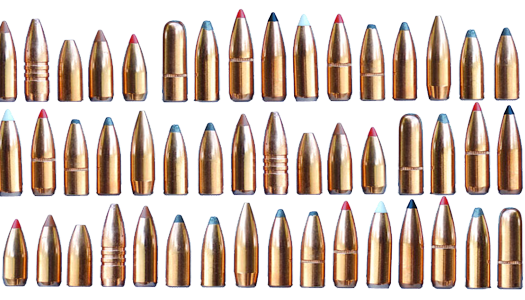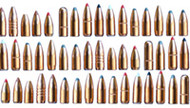Bullet Basics
Posted by Gunstop on 21st Apr 2015

The bullet may arguably be the most important component of your reloading formula. It's the only part that needs to reach the target accurately and safely every time. Handloaders today are blessed with a huge variety of bullets to choose from, but that can also make the choice confusing. Here are the basics of bullet selection to help you determine what may be best for your application.
Weight
Bullet weight is the first thing many people consider. This is the physical weight of the projectile only, measured in grains. There are 437.5 grains in an ounce. For reference, the standard solid shotgun slug is 1 ounce, whereas the standard 45 ACP projectile is 230 grains.
In general, heavier bullets will deflect the wind better and be more stable when passing through barriers or soft targets. Lighter bullets will have more velocity, but be blown off target by the wind easier or tumble when striking objects.
Another thing to consider is the “twist rate,” or your firearm's barrel. This is a number that represents the inches per full turn of the barrel rifling; 1:10, for example, means the bullet will make one complete spin per 10 inches of barrel.
A bullet must be spun adequately to ensure accuracy, and heavier bullets will need a “faster” twist rate to be properly stabilized. For instance, the heavy 77 grain 223 caliber bullets should be fired from a 1:7 barrel, while the lighter 55 grain projectiles are properly stabilized with only a 1:9 twist.
Things To Consider
- What is the optimal weight for my firearm's twist rate?
- What weight is needed for a humane kill if hunting?
- How important is velocity and wind deflection?
- Will I be shooting through brush or barriers?
Bullet Shape & Type
There are a few main types of bullet shapes, each with unique advantages and applications. The classic “spitzer” shape is what most people imagine when they think of a bullet. This is the solid pointed shape, which is best for general purpose applications.
Hollow point bullets have a cavity in the nose that allows the jacket and lead core to expand, greatly increasing the size of any wound created. These are typically used for hunting, but suffer some accuracy issues as the nose is not pointed. Bullets are usually referred to as either hollow point or “full metal jacket,” meaning the lead core is almost completely covered by a copper jacket.
Soft point bullets mostly maintain the spitzer shape, but have part of the lead core protruding from the bullet tip. This makes a very lethal bullet still capable of longer-range shots. Even better for long range hunting are ballistic tip bullets, which have a hollow point but are tipped with plastic to retain a perfect point. For even more accuracy, open tip or OTM (open tip match) bullets can be used. These have a spitzer shape with a small hole in the tip left from the manufacturing process. They tend to be extremely consistently shaped and offer reliable long-distance performance.
There are also round nose and flat nose or “wadcutter” shapes. These bullets are typically used in handguns for recreation and target practice. These shapes are best for shorter-distance shooting, and firearms with a tubular magazine where it’s not safe to load pointed bullets.
On the backside of the bullet, you will either be choosing a flat design or “boat tail.” Boat tail bullets have a curved backside that creates a more aerodynamic shape, increasing velocity. Boat tail bullets are usually chosen by long-distance shooters who need the maximum velocity possible to hit targets are great distances.
Things To Consider
- Is maximum accuracy needed?
- Is expansion needed to create a large wound cavity for hunting?
- Is velocity or stability more important?
- What is safe to use in your firearm?
Materials & Construction
The most common materials in bullet construction are lead and copper. Most bullets have a solid lead core covered by a thin layer of copper. Bullets designed to be extremely stable after hitting targets or to pierce armor or thick barriers will often have steel cores or a steel tip.
Since lead is toxic to the environment and animals, many hunters are now choosing to buy solid copper projectiles. These forgo any lead or other metals and simple use a solid piece of copper.
For training and close-distance steel target shooting, many people utilize frangible bullets. These projectiles are created from compressing tiny copper beads into the bullet shape. They safely disintegrate when hitting a solid object, making close distance shooting possible without the danger of ricochet or over penetration.
The construction of most bullets is referred to as “full metal jacket.” or "FMJ" for short. This simply means the lead core is covered in a copper jacket. The jacket is drawn from the tip to encase the lead. This is the most efficient process of jacketing bullets, but is less precise than open tip construction where the jacket is drawn from the base of the bullet.
Hollow point and soft point bullets are constructed with a jacket that leaves much of the lead core exposed. This flattens the projectile on impact, increasing its diameter and wounding potential. Because the bullet is changing shape after impact, however, it can come apart and become less effective. High quality projectiles of this type will be better at retaining the jacket to core construction after impact.
Things To Consider
- Does the projectile need to retain its shape and weight after impact?
- Will I be shooting at hard object at close distances?
- Will wildlife potentially find and ingest my used projectiles?
- What penetration and stability requirements do I have?
Choosing the best bullet weight, shape, and type is an interesting component of reloading. The more you experiment and test your loads, the more you will come to understand the effects of bullet choice.

